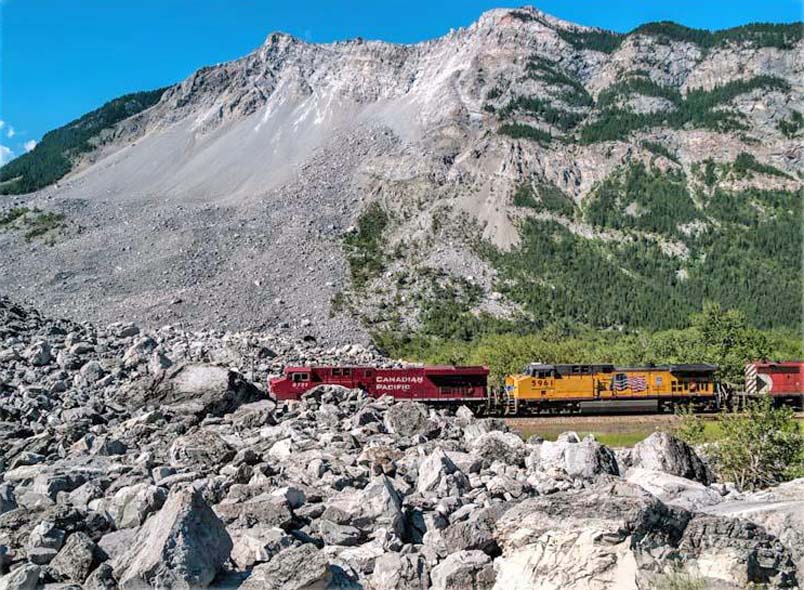

Crowsnest Pass Alberta - Backstory: Canada's deadliest rockslide (the Frank Slide) broke free from the summit of Turtle Mountain in the
early morning darkness of 29 Apr 1903.
It cascaded across the Crowsnest River valley, and within a long minute, buried the valley floor and killed an estimated 100 people.
A second rockslide has long been predicted.
No one knows when it will occur.
News flash: Crowsnest Pass Council, in recent action, passed a bylaw that redefined and renamed what it refers to as the Turtle Mountain Restricted Development
Area (RDA).
This new bylaw has created confusion on at least two fronts.
The most mind-muddying aspect is this.
There are now two RDAs within the Crowsnest River valley at the base of Turtle Mountain, and they're polar opposites.
They differ in their legal land descriptions, their founding rationale, and stand in opposition to each other in the outcomes they're intended to
deliver.
The Frank Slide's first RDA designation, it remains valid, was made by the Government of Alberta in 1976.
Its stated purpose, protect the area's natural resources, the watershed, and the area's plants and animals.
The vision: preservation of the environment.
Many people have assumed, falsely, the Frank Slide was (circa 1976) designated a RDA because of the land's inherent risk of being buried beneath the forecast
(second) rockslide to fall from Turtle Mountain.
It wasn't, but this isn't to say the provincial government did not attempt to move people out of perceived danger.
It issued warnings and offered financial incentives.
These efforts were largely unsuccessful in relocating people and their homes from the valley's deemed-most-dangerous areas, and in preventing new development
from occurring.
A second provincial designation (1977) identified the Frank Slide as a Provincial Historic Resource.
This gave the Frank Slide protection from development under the Historical Resources Act.
The two designations combine to preserve the Frank Slide's esthetic appeal as well as its cultural, historical, and geological significance, and protect the
rockslide from further disturbance and development.
The clear intent of these two overlapping-in-vision designations was to secure and shelter the entire footprint of the Frank Slide as a revered provincial and
national treasure.
Unfortunately, the designations, instead of formally identifying and mapping the entire Frank Slide footprint, mapped, to varying degrees, most of the Frank
Slide's footprint, but not all of it.
This opened the door to further ill-advised construction, and with it, elevated risk to human life.
It also created the potential for the Frank Slide's still-buried dead to be unintentionally exhumed, and it set the stage for some of the 1903 rockslide's
virtual sea of fractured-rock tombstones to be un-caringly moved or destroyed.
(Contemplate the excavation of a portion of the Hillcrest Cemetery for a comparison.)
The Municipality of Crowsnest Pass' new bylaw reduced the size of its (municipally defined) RDA in order to enlarge the area where development would be
allowed.
Does this action not violate the intent of the Frank Slide's Provincial Historical Resource designation and the intent and purpose of the (provincially
defined) Turtle Mountain RDA?
Does it not elevate the potential for the anticipated future rockslide to destroy human life and infrastructure?
Looking past legal aspects of the preceding, isn't it inherently dangerous to play games with best-guess future rockslide projections when human lives are at
stake?
Scientists and engineers have created projections that portray and convey Turtle Mountain's anticipated future rockslide dynamics.
These detailed predictions reveal a range of possibilities.
Within the broad spectrum of possible outcomes there is no precise, footprint-defining, conclusion.
Because of this, I suggest there is no sound rationale for a bylaw that opens the door to new home and business construction a hair's breadth beyond the outer
margin of one report's envisioned hypothetical edge of a deemed-most-likely scenario for future destruction.
The scientists who have studied Turtle Mountain know this.
The mountain has the very real potential to produce a rockslide that crashes across the valley floor to bury the Canadian Pacific Railway and Highway
3.
All contemporary rockslide run-out projections expose this possibility.
And there's more.
No projection for a future rockslide from Turtle Mountain takes into account the possibility of an earthquake, such as the one in 1992, that caused a large
rockslide to rumble down the north face of Chief Mountain (Montana), a mountain that, in structure, is a virtual duplicate of Crowsnest Mountain.
An overnight earthquake has the potential to bury all current Turtle Mountain rockslide run-out projections and render the current advanced warning system
meaningless.
No projection for a future rockslide from Turtle Mountain considers the potential for human-induced seismicity, such as that caused by fracking to, without
warning, suddenly destabilize the mountain.
No projection for a future rockslide from Turtle Mountain addresses the potential for close-proximity mine blasts, such as those that can be expected if the
proposed Grassy Mountain Coal Project and/or other similar proposals are approved, to accelerate or trigger Turtle Mountain's second coming.
My suggestion to Crowsnest Pass Council is that it work with the Alberta government to ensure the province's two Frank Slide protecting designations deliver
their intended safeguards, the protection of Alberta's cultural and natural history resources, and its people.
David McIntyre.
provisions in Section 29 of the Canadian
Copyright Modernization Act.

